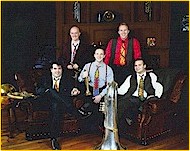|
|
|
 |
|
|
|
|
|
American
Premieres
|
|
|
|
| The
opportunity to actually perform a foreign work
in the USA for the very first time occurred
almost by accident. |
 |
|
| One
morning a local classical radio station was
already playing some brass music, when my
clock-radio woke me.
The music being played was interesting
and enjoyable, and it seemed obvious the
performers were having the same delight in
playing it. |
|
|
|
|
| As it
progressed, I was struck by the design: it was in
several movements, some rather brief and sprightly,
others darkly mysterious.
When it reached the final movement, it was as
though a parade was about to begin!
That's how much excitement the composer conveyed. |
|
|
|
|
Well,
I got to a pen and paper to be sure that I got the
information. It
was on a London Brass CD called "Clowning
Around". London
Brass is an ensemble whose central unit is a brass
quintet. To
this they add an additional five players for larger works
as well. It
is this group that has carried on the work begun by Philip
Jones.
|
|
|
|
|
As
complex as this music became (at times), it was quite
clearly a brass quintet.
Wonderful! This
meant that if I could get the music, Boston Brass could
play it. After buying the CD, I called a local music seller to see if
they could find the work.
It was discovered that it was published in Holland,
and the importer was in New Jersey.
|
|
|
|
| I
called them and asked if they could find it in their
Holland catalogs. Eventually
they did. It
had never been sold in this country -- it was very
expensive. The
score alone then sold for about $50.00 (in 1990). That didn't matter to me, because this was an outstanding
piece. |
|
|
|
| The
work I'm describing is by Jan Koetsier -- "Kinderzirkus".
It consists
of nine movements, some of which are pretty short. Of the nine, there's a Little Circus March ("Kleiner
Zirkusmarsch"), three "Clown" movements
("Clownerie I/II/III"), a High-wire Artist
("Die Seiltanzerin"), a Juggler ("Der
Jongleur"), a Dancing Bear ("Der Tanzbar"),
a Magician ("Der Zauberer"), and a Grand
Finale ("Grosses Finale"). |
|
|
|
| The
first movement, the Little Circus March, was actually
written several years before the others. It wasn't until later, when Koetsier was approached to add
the other circus characters, that the entire suite was
finished. |
|
|
|
| This
was the "work of choice" that Boston Brass
prepared for Round 3 of the 1992 Narbonne competition
(hoping, of course, to get to that final round). |
|
|
|
| It is
a sheer delight to play and brings some elements of
spontaneity to it's every performance. We were just lucky to be the first group to play it in this
country. |
|
|
|
| ROGER
DELANOFF
|
|
|
|
|
About
a year before finding "Kinderzirkus", I got a
mailing from Germany.
I couldn't read the letter, but music that came
with it posed no such problem.
Soon I determined that it was from a composer named
Roger Delanoff. I
did not know him and had never heard of him.
His letter contained some biographical information,
and it seemed that he had written quite a bit of music for
various ensembles.
|
|
|
|
|
|
I
don't know how he found me.
|
|
|
|
|
|
What
he sent me was a copy of his "Concerto for Brass
Quintet". It
was in his own hand written manuscript (it didn't get
published until the later 1990s).
When the quintet played through it, we immediately
felt that it had something good to offer.
|
|
|
|
|
|
Probably
what we all like most about it was the slow second
movement. It
was unlike many other "modern" works, in that it
had a strong melodic element with definite Romantic
harmonies, yet it did not sound like that particular
style. The
evocative character of this movement won us over, and it
was premiered on the same concert as "Kinderzirkus",
sometime in 1990.
|
|
|
|
|
|
I
would periodically get letters or postcards from Mr.
Delanoff. He
is definitely a cordial person.
|
|
|
|
|
|
About
three years later I got another big mailing from him. This time it was a work for ten-piece brass choir,
"Munich Concerto".
This was in four movements, all fine writing.
Again, the slow movement takes the cake, but this
time he bravely includes some pretty high piccolo trumpet
writing.
|
|
|
|
|
|
With
other mailings from Mr. Delanoff I have also received a
"Sonata for Trumpet and Piano" -- a very early
work from around 1964, and with yet another beautiful slow
middle movement -- and a solo for unaccompanied trumpet.
The title of this is also its dedication: The name
of a German trumpeter, Uwe, is the root of its title.
I performed the Sonata a few times in the
mid-1990s. It's
not particularly difficult, but it is unusual and that
makes for some good programming.
|
|
|
|
|